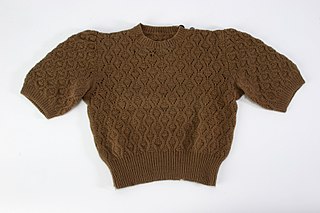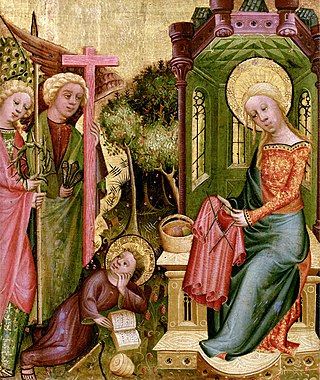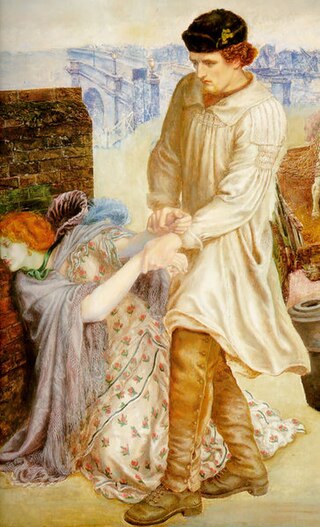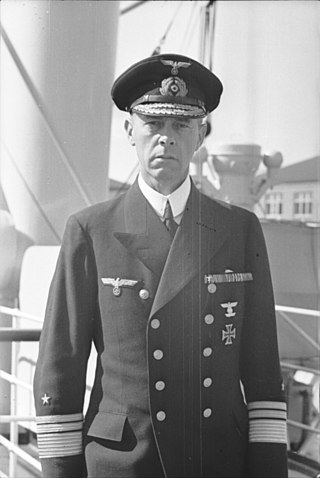
A guernsey, or gansey, is a seaman's knitted woollen sweater, similar to a jersey, which originated in the Channel Island of the same name, sometimes known as a knit-frock in Cornwall, especially Polperro. [1]

A guernsey, or gansey, is a seaman's knitted woollen sweater, similar to a jersey, which originated in the Channel Island of the same name, sometimes known as a knit-frock in Cornwall, especially Polperro. [1]
The guernsey is the mainstay of Guernsey's knitting industry which can be dated back to the late 15th century when a royal grant was obtained to import wool from England and re-export knitted goods to Normandy and Spain. Peter Heylin described the manufacture and export of "waste-cotes" during the reign of Charles I. The first use of the name "guernsey" outside of the island [2] is in the 1851 Oxford Dictionary,[ clarification needed ] but the garment was in use in the bailiwick before that. [3]
The guernsey was traditionally knitted by the fishermen's wives and the pattern passed down from mother to daughter through the generations. While commercially available sweaters are machine knit, the final finishing of these machine-knit parts is completed by hand. [4]
Mary Wright argues that the use and wearing of guernseys throughout the British Isles for over a century and a half almost justifies the guernsey for qualification as a national costume. [5] A guernsey from the Folk Museum Guernsey was included in the 2010 BBC project A History of the World in 100 Objects . [6]
The term can also refer to a similarly shaped garment made of woven cloth, also called a Guernsey shirt or smock. There are a number of different names for the same garments, for instance Guernsey frock, Guernsey shirt, smock-frock, or fisherman’s frock. Essentially these are all the same garment, with the materials varying based on the purpose for which it is worn. [7]
Two styles of guernsey exist: a plain "working" guernsey and a "finer" example that was generally saved for special occasions and Sunday-best attire. [8] Traditionally, Ganseys were seamless and worked in the round using the circular knitting method.
The "working" guernsey design was kept simpler in order to reduce the amount of time and materials needed to produce. The sale of knitted garments to supplement family income was important to many island families and thus the garments that were sold were also of a simple design. It is estimated that a total of 84 hours was needed to complete a guernsey: a simpler design could be produced faster than a more elaborate one. [9]
Twenty-four principal patterns have been identified in Cornwall alone, each one again drawing inspiration from ropes, chains, waves, nets and sand-prints. [5]
Worn as a source of pride and often knitted by prospective wives "to show the industrious nature of the woman he was about to marry", the "finer" guernsey was more elaborately patterned than its working cousin. [8] With the advent of the machine-knitted guernsey and the decline in the knitting industry, this guernsey is a much rarer sight.
It is not uncommon for a guernsey to last several decades and be passed down in families. Guernseys knitted for children were knitted to be "grown into" and often came down to the knee. [5]
The guernsey was first widely used in the rating uniform of the 19th-century British Royal Navy. [10] [11] It is said that guernseys were worn at the Battle of Trafalgar (although these were probably made from woollen cloth, rather than knitted [7] ).
Orders for variants of the guernsey have also come from the Intelligence Corps, the Mercian Regiment, the Tank Regiment and Gurkha Logistics where they form part of officer uniforms. [12]
The translation for the word "jumper" or "sweater" in the Goidelic languages, Irish, Scottish Gaelic and Manx, are "geansaí", [13] "geansaidh" [14] and "gansee" [15] respectively, all borrowings from the English guernsey/gansey. The Norwegian word "genser" is derived from "guernsey" and means sweater or jumper. In Danish a guernsey is called a "sømandstrøje", meaning a seaman's sweater.

A jumper, jumper dress, or pinafore dress is a sleeveless, collarless dress intended to be worn over a blouse, shirt, T-shirt or sweater. Hemlines can be of different lengths and the type of collar and whether or not there is pleating are also variables in the design.

A sweater or pullover, also called a jersey or jumper, is a piece of clothing, typically with long sleeves, made of knitted or crocheted material, that covers the upper part of the body. When sleeveless, the garment is often called a slipover, tank top or sweater vest.

A cardigan is a type of knitted sweater that has an open front, and is worn like a jacket.

Traditionally, a jersey is an item of knitted clothing, generally made of wool or cotton, with sleeves, worn as a pullover, as it does not open at the front, unlike a cardigan. It is usually close-fitting and machine knitted in contrast to a guernsey that is more often hand knit with a thicker yarn. The word is usually used interchangeably with sweater.

The Aran jumper is a style of jumper that takes its name from the Aran Islands off the west coast of Ireland. A traditional Aran Jumper usually is off-white in colour, with cable patterns on the body and sleeves. Originally the jumpers were knitted using unscoured wool that retained its natural oils (lanolin) which made the garments water-resistant and meant they remained wearable even when wet.

Knitting is the process of using two or more needles to pull and loop yarn into a series of interconnected loops in order to create a finished garment or some other type of fabric. The word is derived from knot, thought to originate from the Dutch verb knutten, which is similar to the Old English cnyttan, "to knot". Its origins lie in the basic human need for clothing for protection against the elements. More recently, hand knitting has become less a necessary skill and more of a hobby.

Frock has been used since Middle English as the name for an article of clothing, typically coat-like, for men and women.
Clothing terminology comprises the names of individual garments and classes of garments, as well as the specialized vocabularies of the trades that have designed, manufactured, marketed and sold clothing over hundreds of years.
Guernsey usually refers to either:

A smock-frock or smock is an outer garment traditionally worn by rural workers, especially shepherds and waggoners. Today, the word smock refers to a loose overgarment worn to protect one's clothing, for instance by a painter.

The Denison smock was a coverall jacket issued to Special Operations Executive (SOE) agents, the Parachute Regiment, the Glider Pilot Regiment, Air Landing Regiments, Air Observation Post Squadrons, Commando units, and other Commonwealth airborne units, to wear over their Battle Dress uniform during the Second World War. The garment was also issued as standard to the scout and sniper platoons of line infantry battalions.
This is a list of existing articles related to fashion and clothing. For individual designers, see List of fashion designers

A sweater vest is an item of knitwear that is similar to a sweater, but without sleeves, usually with a low-cut neckline. They were popular in the 20th century, particularly in the 1970s in the UK, and are again growing in popularity in this century.
The Gunnister Man is the remains of a late 17th or early 18th century man found by two Shetlanders in a peat bog not far from the junction of the A970 road in Gunnister, Shetland, Scotland. The bog body was found on 12 May 1951 as the men were digging peat for fuel. A stone placed by the Northmavine History Group now marks the find location.

Cowichan knitting is a form of knitting characteristic of the Cowichan people of southeastern Vancouver Island, British Columbia. The distinctively patterned, heavy-knit Cowichan sweaters, popular among British Columbians and tourists, are produced using this method. Cowichan knitting is an acculturated art form, a combination of European textile techniques and Salish spinning and weaving methods. From this union, new tools, techniques and designs developed over the years.

The Kriegsmarine was the navy of Nazi Germany prior to and during World War II. Kriegsmarine uniform design followed that of the preexisting Reichsmarine, itself based on that of the First World War Kaiserliche Marine. Kriegsmarine styles of uniform and insignia had many features in common with those of other European navies, all derived from the British Royal Navy of the 19th century, such as officers' frock coats, sleeve braid, and the "sailor suit" uniform for enlisted personnel and petty officers.

Away colours or road colours are a choice of coloured clothing used in team sports. They are required to be worn by one team during a game between teams that would otherwise wear the same colours as each other, or similar colours. This change prevents confusion for officials, players, and spectators. In most sports, it is the visiting or road team that must change.

A herringbone stitch is a needlework stitch used in embroidery, knitting and crochet. It is so named as it resembles the bones extending from the spine of a herring fish. In knitting, it is a stitch that creates a fabric pattern closely resembling a herringbone pattern, or herringbone cloth.

A guernsey is a type of shirt worn by Australian rules footballers. It is typically sleeveless, although long sleeves may also be worn. The word "jumper" is also used to describe a guernsey.
Aran knitting patterns are heavily textured knitting patterns which are named after the Aran Islands, which are located off the west coast of Ireland from County Galway and County Clare. The patterns are knitted into socks, hats, vests, scarves, mittens, afghans, pillow covers, and, most commonly, sweaters.